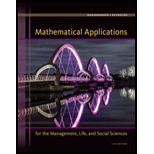
(a)
To calculate: The function for the instantaneous rate of change of the number of beneficiaries, if the function for the number of beneficiaries (in millions) t years past 1950 model as
| Year | Number of Beneficiaries (millions) | Year | Number of Beneficiaries (millions) |
| 1950 | 2.9 | 2000 | 44.8 |
| 1960 | 14.3 | 2010 | 53.3 |
| 1970 | 25.2 | 2020 | 68.8 |
| 1980 | 35.1 | 2030 | 82.7 |
| 1990 | 39.5 |
(b)
To calculate: The instantaneous rate of change of the number of beneficiaries in 2020 and its interpretation, if the function for the number of beneficiaries (in millions) t years past 1950 model as
The data that gives the number of Social Security beneficiaries (actual and projected) for selected years from 1950 through 2030 for which the function is modeled is tabulated below
| Year | Number of Beneficiaries (millions) | Year | Number of Beneficiaries (millions) |
| 1950 | 2.9 | 2000 | 44.8 |
| 1960 | 14.3 | 2010 | 53.3 |
| 1970 | 25.2 | 2020 | 68.8 |
| 1980 | 35.1 | 2030 | 82.7 |
| 1990 | 39.5 |
(c)
The time range among (from 2010 to 2020, from 2020 to 2030 orfrom 2010 to 2030) for which the average rate of change is the best approximates of the instantaneous rate of change in 2020, if the function for the number of beneficiaries (in millions) t years past 1950 model as
The data that gives the number of Social Security beneficiaries (actual and projected) for selected years from 1950 through 2030 for which the function is modeled is tabulated below
| Year | Number of Beneficiaries (millions) | Year | Number of Beneficiaries (millions) |
| 1950 | 2.9 | 2000 | 44.8 |
| 1960 | 14.3 | 2010 | 53.3 |
| 1970 | 25.2 | 2020 | 68.8 |
| 1980 | 35.1 | 2030 | 82.7 |
| 1990 | 39.5 |
Want to see the full answer?
Check out a sample textbook solution
Chapter 9 Solutions
Mathematical Applications for the Management, Life, and Social Sciences
- Solve the equation. Write the smaller answer first. 2 (x-6)² = 36 x = Α x = Previous Page Next Pagearrow_forwardWrite a quadratic equation in factored form that has solutions of x = 2 and x = = -3/5 ○ a) (x-2)(5x + 3) = 0 ○ b) (x + 2)(3x-5) = 0 O c) (x + 2)(5x -3) = 0 ○ d) (x-2)(3x + 5) = 0arrow_forwardA vacant lot is being converted into a community garden. The garden and a walkway around its perimeter have an area of 690 square feet. Find the width of the walkway (x) if the garden measures 14 feet wide by 18 feet long. Write answer to 2 decimal places. (Write the number without units). Hint: add 2x to each of the garden dimensions of 14 x 18 feet to get the total area for the length multiplied by width.arrow_forward
- Solve the rational equation 14 1 + x-6 x x-7 x-7 ○ a) x = 1, x = 8 ○ b) x = 1 ○ c) x = 7 ○ d) x = 1, x = 7arrow_forwardSolve the absolute inequality | x + 5 > 3 ○ a) (-∞, -8] U[-2, ∞0) ☐ b) (-8, -2) c) (-2, ∞0) ○ d) (-∞, - 8) U(-2, ∞0)arrow_forward1) Listen Describe the error in the problem X 3 X x 3 - 2 = 25x = 0 25x 25 x = ±5arrow_forward
 Linear Algebra: A Modern IntroductionAlgebraISBN:9781285463247Author:David PoolePublisher:Cengage Learning
Linear Algebra: A Modern IntroductionAlgebraISBN:9781285463247Author:David PoolePublisher:Cengage Learning Holt Mcdougal Larson Pre-algebra: Student Edition...AlgebraISBN:9780547587776Author:HOLT MCDOUGALPublisher:HOLT MCDOUGAL
Holt Mcdougal Larson Pre-algebra: Student Edition...AlgebraISBN:9780547587776Author:HOLT MCDOUGALPublisher:HOLT MCDOUGAL College Algebra (MindTap Course List)AlgebraISBN:9781305652231Author:R. David Gustafson, Jeff HughesPublisher:Cengage Learning
College Algebra (MindTap Course List)AlgebraISBN:9781305652231Author:R. David Gustafson, Jeff HughesPublisher:Cengage Learning Glencoe Algebra 1, Student Edition, 9780079039897...AlgebraISBN:9780079039897Author:CarterPublisher:McGraw Hill
Glencoe Algebra 1, Student Edition, 9780079039897...AlgebraISBN:9780079039897Author:CarterPublisher:McGraw Hill



